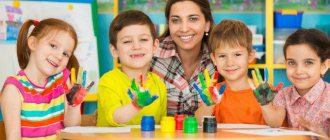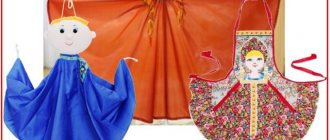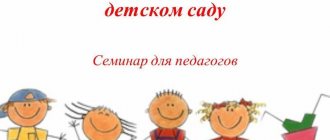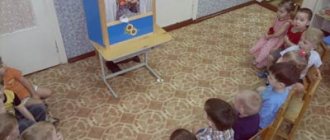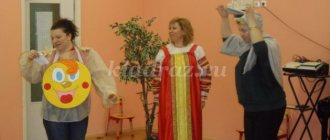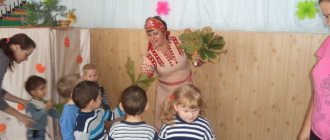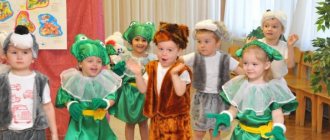CHILDHOOD GUIDE
Master class for educators
“Use of gaming methods and techniques
in organizing theatrical activities"
Ustinova Olga Viktorovna,
teacher of MKDOU No. 16,
Novosibirsk city
Goal: developing the competence of teachers in the use of gaming methods and techniques in organizing theatrical activities. Objectives: 1. Determine the importance of the creative development of preschool children.
2. Clarify the stages of working on the role.
3. Determine methods and techniques for organizing theatrical activities.
4. Apply gaming theatrical methods and techniques in other educational areas in practice.
Progress of the master class:
Dear Colleagues! We all know that childhood is a time of continuous exploration of the world, and theatrical activities provide an opportunity to explore it more easily and naturally. Properly selected methods and techniques help in this. Our master class is devoted to gaming methods and techniques of theatrical performance.
“ The first stage is defining the image . Its task is to teach children to recognize a specific image, highlighting the characteristic features unique to it. Let's consider the method - “ reading contrasting passages .” Let us choose for demonstration a well-known fairy-tale character - a fox. It is necessary to recognize which particular image of a fox is inherent in a particular scene and characterize it.
- The grandfather caught a fish, went home, and saw: the fox had curled up and was lying on the road, lying motionless, as if dead. Grandfather threw her into the sleigh and drove home, and the fox threw fish after fish onto the road.
- Fox-Alice is the companion of her friend the cat Basilio; in order to make money, she and Basilio tried to get 5 gold coins that Pinocchio received from Karabas-Barabas.
After reading, the teacher-listeners characterize the images they heard in accordance with the questions posed:
- How do you imagine the fox Alice? (Suggested answers: persistent, assertive, extravagant, etc.)
- What kind of little fox-sister did you see? (cautious, cunning, predatory, etc.)
So, using the method of “reading contrasting passages,” two different images of the fox appeared before you.
The second stage is working on facial expressions. His task is to teach children to convey the emotional state of characters using facial expressions. You can use the game - Guess who I am?
The hero of the work is spoken into the children's ears; the child must show the hero without words so that others can guess.
4 people come out, I say heroes, the teachers must show, and the rest must guess (sister fox, cowardly hare, Mikhailo Potapych, angry wolf).
mirror technique is also used to work on facial expressions (especially when the child is shy, you can do it individually, the child takes a mirror, looks in it and imagines himself as a hero, for example: I am a gray wolf, I am not afraid of anyone!!! Or - I am a brave hare, I I'm not afraid of the wolf!!! I am a little fox-sister, the most beautiful in this forest!!!
The third stage is working on the voice . Its task is to develop children’s speech apparatus and improve intonation expressiveness. Let's consider the technique - “ intonation expressiveness ”.
The task for one half of the teachers is to say the phrase of the little fox-sister: “I am a fox, I am a little sister, I walk quietly.”
The task for the second one is to say the phrase of Alice the Fox: “Oh, there you are, Pinocchio... I’ll explain everything to you now.”
Phrases must be pronounced with different intonations inherent in a certain image of a fox.
Now let's get 4 people out and practice.
1. Bear - Fox:
The bear went to the hut and growled: “Get out, fox!” And she said to him from the stove: “As soon as I jump out, as soon as I jump out, the scraps will go down the back streets!”
2. Rooster - Fox:
Ku-ka-re-ku! I'm walking on my feet in red boots. I carry the scythe on my shoulders, I want to whip the fox - the fox gets out of the oven! - Oh oh oh! I'm getting ready and putting on my fur coat. Petenka, I'm running away!
While completing the task, each participant pronounces the proposed phrase with a different emotional coloring.
Thus, using the technique of “intonation expressiveness” you can give emotional coloring to speech.
To work on the voice, the technique of “voice improvisation ” is used to expand the range and timbre of the voice in accordance with the character proposed; Text.
In a clearing, in a meadow, three bears lived,
Three bears lived and loved to eat raspberries. As soon as they find a raspberry, they will sing a song. Papa Bear sang low: “la-la-la-la-la-la.” Mom sang a tender song: “la-la-la-la-la-la.” And Mishutka the bear sang a song loudly, Yes, he finished eating raspberries: “ La la la la la la".
Teachers (3 people) choose a picture with a certain instrument that matches the sound of the voice timbre of the proposed characters. Next, they imitate the character’s voice, singing and playing the text.
To improve the skill of clear pronunciation, tongue twisters and training in clear pronunciation of vowels and consonants in different parts of the word are used.
To develop diction, imitation of sounds :
-Snorting horses, grunting piglets, meowing kittens, barking dogs...
The fourth stage is working on gesture and movement . Its task is to teach children to move in accordance with a given topic. Let's get acquainted with the game method for memorizing various actions using the "Repeat" game.
To carry it out, I call four people from the teachers.
Q: Rules of the game:
— jointly choose a specific image of a fox (fox-sister);
- the first participant shows one movement inherent in the chosen image;
- the task of each subsequent participant in the game is to reproduce the movement or gesture of the previous participant and add their own element that complements the image.
Also, to work on gesture and movements, the method of acting with imaginary objects ( 3 people ) is used:
One has a birthday, guests come to him and bring imaginary gifts. With the help of expressive movements they show, and the birthday person must guess what they are giving him.
You can also use the method of displaying what has been read (1 person):
The cat sat down on the window and began to wash her ears with her paw. Then she thought a little - I decided to wash the little breast. She remained pleased with herself and played around with her fluffy tail.
Thus, memory games for various actions contribute to the development of children’s motor activity through gesture-image coordination.
The fifth stage is learning the role. His task is to learn the text of a specific role.
“The “Little Book ” technique is used directly while reading the text. Children are asked to cover their faces with their palms and remember as many sentences from the text as possible. Then, with a gesture, the palms “turn” into an open book. Children, without being distracted from the “imaginary book,” take turns, as it were, “reading” from it those sentences that they remember. To build a previously read text from these sentences, children take turns reproducing the text sentence by sentence. The teacher asks who remembered the very first sentence, the second, the third sentence, and so gradually, with the help of the teacher, the text is built.
For example: Mom and dad bought me a kitten. The kitten was small. I gave him milk. The kitten slept often. And when he woke up, he played with me.
The phrase in a circle method is also used to develop speech . Children stand in a circle, start with one word and, in turn, each child repeats the previous one, adding one word to make a sentence.
Bottom line: In addition to the methods shown today, there are many different techniques for organizing theatrical activities .
Theatrical activities have not exhausted their potential and continue to actively involve children in the creative process.
It is very important to look for new methods and techniques, to create a specific subject-environment environment that contributes to the development of the child’s creative personality. Program for organizing theatrical activities Using theatrical activities in kindergarten The role of theatrical activities in kindergarten Using various techniques in teaching children to draw different types of landscapes >
"Dramateshka" is the largest archive of children's plays in RuNet
Based on the tasks for the development of theatrical activities with preschoolers, its content of work in kindergarten is determined (Appendix 3). However, the forms of organization can be different. For example, L.V. Kutsakova and S.I. Merzlyakova distinguish: classes (frontal, subgroup and individual), holidays, entertainment, performances, theatrical actions (Scheme 6). The main form is occupation. Forms of organizing theatrical activities (Diagram 6)
L.V. Kutsakova and S.I. Merzlyakova identified the following types of theater classes (Diagram 7)
Typical ones, which include the following types of activities: theatrical gaming, rhythmoplasty, artistic speech, theatrical alphabet (elementary knowledge of theatrical art). Dominant - one of the specified types of activity dominates. Thematic, in which all the named types of activities are united by one topic, for example: “What is good and what is bad?”, “About dogs and cats,” etc. Complex - a synthesis of arts is used, an idea is given about the specifics of the arts (theater , choreography, poetry, music, painting), about modern technical means (audio, video materials). All types of artistic activity are united, alternate, there are similarities and differences in works, means of expression of each type of art, conveying the image in their own way. Integrated, where the core activity is not only artistic, but also any other activity. Rehearsal rooms, where a “run-through” of the performance being prepared for production or its individual fragments is carried out. When organizing classes, it is necessary to remember that knowledge and skills acquired without desire and interest do not stimulate the cognitive activity of preschoolers. Questions: 1. List the main forms of organizing theatrical activities with preschoolers. 2. Name the types of theater classes in preschool educational institutions. Assignment for independent work: Prepare a summary of one type of theater lesson with children of senior preschool age. Literature 1. Antipina E.A. Theatrical activities in kindergarten.-M., 2003. 2. Botnar V.D., Suslova E.K. Dramatization games are the basis for acquaintance with the culture of other peoples // Preschool education. – 1994. – No. 3. 3. Konovich A.A. Theatrical celebration and rituals. – M., 1990. 4. Kutsakova L.V., Merzlyakova S.I. Raising a preschool child: developed, educated, independent, proactive, unique, cultural, active and creative. - M.: Vlados, 2004. 5. Makhaneva M. Theatrical activities of preschoolers // Preschool education. – 1999. – No. 11. 6. Sorokina N.F. Playing puppet theater: Program “Theatre-creativity-children.”-M.: ARKTI, 2004. 7. Churilova E.G. Methods and organization of theatrical activities for preschoolers and primary schoolchildren. - M.: Vlados, 2001.
The problem of communication abilities is the focus of attention of social psychologists due to its significance in all spheres of every person’s life.
Communication – the ability to communicate with peers and adults, understanding and self-awareness.
Communication is an important indicator of a child’s mental development. A person without communication cannot live among people. Communication is not just an action - it is precisely an interaction: it takes place between participants.
Modern society places high demands on the communicative activity of an individual. Society needs creative individuals who can think outside the box, express their thoughts competently, and find solutions in any life situations. In preschool age, children easily acquire new knowledge, retain and retain developed skills and abilities.
Communication activities involve:
1. Mutual enrichment of children with new learning experiences and forms of interaction.
2. Children’s mastery of different types of activities.
3. Establishing emotional interaction with children and adults.
Currently, the communicative development of a preschooler is alarming. It's no secret that TV and computers, computer games, have begun to replace communication and gaming activities for both children and adults. Communication and only live human communication enriches the lives of children.
Many children have impaired communicative speech function. Such children have unstable attention, poor memory, fatigue, insufficient development of cognitive activity, poor vocabulary, impaired grammatical structure of speech, and an immature emotional-volitional sphere. Preschoolers experience inhibitory processes and may exhibit timidity and stiffness. Children begin to be critical of their defects. Preschoolers cannot always formulate their thoughts correctly, answer questions correctly, cannot ask questions correctly, find it difficult to establish contact with both adults and peers, cannot conduct a restrained conversation with friends, enter into conflicts and find it difficult to resolve them peacefully and in a polite manner.
The ability to communicate is the most important condition for the successful social and intellectual development of a child. Considering that play in preschool age is the leading activity, it has become one of the most effective and accessible ways to develop the communicative abilities of preschoolers.
Theatrical play is a means of developing communication among preschool children. It is a good opportunity to reveal a child’s creative potential and nurture a creative personality. Children learn to notice interesting ideas in the world around them, embody them, create their own artistic image of a character, children develop creative imagination, associative thinking, and the ability to see unusual moments in the ordinary.
Collective theatrical activities are aimed at a holistic impact on the child’s personality, his emancipation, involvement in action, while activating all his capabilities; for independent creativity; development of all leading mental processes; promotes self-knowledge and self-expression of the individual with a fairly high degree of freedom; creates conditions for the socialization of the child, strengthens his adaptive abilities, corrects communication deviations; helps to realize the feelings of satisfaction, joy, significance that arise as a result of identifying hidden talents and potentials.
Theatrical activity simultaneously performs a cognitive, educational and developmental function.
The educational possibilities of theatrical activity are great, as it contributes to the development of the following communicative abilities:
1. Getting to know the world around you.
2. Formation of mental processes (attention, perception, memory, thinking, imagination).
3. Speech development (vocabulary, grammatical structure of speech, sound culture of speech, coherent speech skills, intonation and expressive speech are improved)
4. Development of the emotional-volitional sphere (the ability to recognize a person’s emotional state by facial expressions, gestures, intonation, the ability to put oneself in his place in various situations, to express one’s own attitude towards good and evil).
5. Formation of primary social behavior skills (kindness, friendship, honesty, courage).
6. The source of the development of feelings, deep experiences and discoveries of the child, introducing him to spiritual values (sympathy, empathy).
7. Improves motor skills, coordination, smoothness, switchability, and purposefulness of movements.
8. An idea of theater as an art is formed, and interest in theatrical and play activities appears.
9. Musical abilities are improved when creating artistic words.
All theatrical activities in my group are organized in such a way that they contribute to the development of mental activity, the development of mental processes, improve speech skills, increase emotional activity and correct communicative behavior.
Theatrical performances and theater games optimize the cognitive development of preschool children, introducing children to the rich world of images, human actions and relationships. The child learns to think through his actions, the actions of the characters, role-playing statements in advance, and selects expressive means - facial expressions, intonation, posture. Brightness, entertainment and allegory, inherent in the art of theater, make it possible to bring to the child’s consciousness sublime ideas about friendship, goodness, justice, and the beauty of human relationships. Theatrical play activities help to develop children's organization, independence, and communication skills. Preschoolers learn to reason consistently and prove their point of view.
Through role-playing statements, dramatic development of the plots of literary works, a preschool child learns the meaning and actively experiments with words, facial expressions, gestures, movements, and masters various ways of expressing thoughts, character, and image of the characters in the play.
By participating in theatrical play activities, children learn about the world and become participants in events from the life of the natural world and people. All theatrical games are based on the material of fairy tales and while playing, children learn to tell a coherent story, feel, convey intonation, actively use movements, facial expressions and gestures
Principles for the development of communicative abilities that are formed in theatrical activities:
1. The principle of intergativity (interrelation with other types of activities).
2. Variety of topics and working methods.
3. Maximum activity of children.
4. Cooperation of children with each other and with adults (relationship between child and adult).
5. Teacher competence.
6. The principle of an individual approach to children (differentiated approach).
7. The principle of game presentation of material.
Types of motivations in theatrical play:
- Social (creating a situation of success, using praise, encouragement, the child’s right to make mistakes).
- Content-based (formation of experience in collective and creative activities, organization of individual work with children).
- Pragmatic (increasing children’s attention to this type of activity and developing cognitive interest).
It is necessary to create a subject-development environment in the group room, which provides the opportunity to simultaneously engage in different types of activities. Our group has decorated theater zones that differ from each other: “mini-museum”, “theater stage”, “in the land of theatre”, “mummering corner”. The creation of such zones encourages children to engage in independent creative activities and play theater.
Theater centers are represented by a variety of equipment and the following materials: books, theatrical masks and individual costume elements, sets of puppets, screens, various types of theaters (bi-ba-bo, shadow, tabletop, spoon theater, finger theater, puppet theater with a “living hand” , parsley theater, variety theater, dramatization theater, theater on platters, theater on an umbrella, theater in a balloon, theater on the palms, theater of pictures (flannelgraph), attributes and decorations (model of a tree, house, flowers, and so on).
Principles of organizing the theatrical environment:
1. The principle of distance (communication between an adult and a child “eye to eye.”
2. The principle of activity, independence, creativity.
3. The principle of stability-dynamism.
4. The principle of integration and flexible zoning (children engage in different types of activities simultaneously without interfering with each other).
5. The principle of emotionality (individual comfort and emotional well-being of each child).
6. The principle of aesthetic organization (a combination of the familiar and the new).
7. The principle of gender and age differences (standards of masculinity and femininity).
Work on developing children's communicative abilities through theatrical activities goes through the main types of activities and in their interrelation; it can be organized in the morning and evening hours, at any free time during the day.
All work must be systematized in such a way that the teacher stimulates the motor, intonation, and creative activity of all children every time.
The development of children’s communicative abilities through theatrical activities, their frequent performances contribute to the realization of children’s creative powers and spiritual needs, emancipation and increased self-esteem, and overall development; manifestation of curiosity, desire to assimilate new information, development of associative thinking, perseverance, manifestation of general intelligence, emotions. Children develop the ability to combine images, intuition, the ability to improvise, develop melodic and intonation expressiveness, and fluency of speech. The most important thing is that participation in theatrical games brings joy to children, arouses active interest, and captivates them.
Literature
1. Artyomova L.V. Theatrical games for preschoolers. M.: Education, 2008.
2. Bodrachenko I.A. Magazine “Modern Preschool Education” No. 3, 2010.
3. Dronova T.N. We play in the theater. Theatrical activities for children aged 4-6 years. M.: Education, 2005.
4. Kasatkina E.I. Game in the life of a preschooler. M.: Bustard, 2010.
5. Kislinskaya T. A. Fairy tale games for palms from the thirtieth kingdom - the solar state. M.: Genesis, 2009.
An essential feature of theatrical activities for children of senior preschool age
In the pedagogical and psychological literature there are various names for theatrical activities: theatrical play activities, theatrical play creativity, theatrical games, theatrical performances, theatrical amateur performances, theatrical activities, etc.
All types of play are, in essence, the child’s art, his creativity. Theatrical play is a typical basis for artistic creativity. Therefore, theatrical play can be called creative play.
Some psychologists are of the opinion that theatrical games cannot be considered as a creative activity, since nothing new is created in them. Indeed, if we approach play with the same standards as adult activities, then the term “creativity” is inappropriate. But this is justified if you look at the problem from the point of view of child development. There is no reason to deny the possibility of creative self-expression of children in theatrical play, since theatrical activity contains creativity and is itself an artistic activity.
According to S.N. Tomchikova, theatrical activity of preschoolers is a specific type of artistic and creative activity, during which its participants master the available means of performing arts and, depending on the chosen role (actor, author, designer, viewer, etc.), participate in the preparation and conducting various types of theatrical performances, becoming familiar with theatrical culture.
Theatrical games are called so, apparently, because of their closeness to theatrical performance. The spectacle is always enjoyable, and the storytelling enhances the game's appeal.
By theatrical games, scholars mean “theatrical games” whose “plots are familiar fairy tales or theatrical performances based on ready-made scripts.”
Theatrical play activities are of great importance for the comprehensive education of children: they develop artistic taste, creative and declamatory abilities, a sense of collectivism is formed, and memory develops.
Feature of theatrical games: They have a ready-made plot, that is, the child’s activity is predetermined by the text of the work. Pedagogical preschool artistic aesthetics of children.
A real theatrical play is a rich field for children's creativity: The text of a work is simply a canvas into which children can weave new storylines, introduce additional roles, change the ending, etc.
It was noted that theatrical games differ from role-playing games not only in the plot, but also in the nature of the gaming activity. Theatrical games are playful performances that have a fixed content in the form of a literary work and are performed by children personally. In them, as in real theatrical art, specific images are created using such means of expression as intonation, facial expressions, gestures, posture and gait.
The pedagogical basis for organizing the process of theatrical activities in preschool educational institutions is the specificity of preschoolers’ perception of theatrical art. In order for this perception to be complete, it is necessary to introduce children to various types of theatrical activities. All theatrical games can be divided into two main groups: Directing games and dramatization games.
The first group - director's games in kindergarten - includes tabletop, shadow theater, and theater on a flannelgraph. Here the child or adult is not an actor, he or she creates the scene, plays the role of a toy character - three-dimensional or flat. He or she acts for him or her, portrays him or her using facial expressions, intonation, and gestures. The child's pantomime is limited. He or she acts with a stationary or sitting figure or toy. The emphasis here is on the language, its themes, intonation, expressiveness, and diction.
MAGAZINE Preschooler.RF
Features of organizing theatrical activities with preschool childrenCurrently, a great deal of theoretical and practical experience has been accumulated in organizing theatrical activities in kindergarten. The works of domestic teachers, scientists, methodologists are devoted to this: N. Karpinsky, A. Nikolaicheva, L. Furmina, L. Voroshnina, R. Sigutkina, I. Reutskaya, L. Bochkareva, I. Medvedeva, T. Shishova and others.
Theater activities should provide children with the opportunity not only to study and understand the world around them through comprehension of fairy tales, but to live in harmony with it, receive satisfaction from classes, a variety of activities, and successful completion of tasks. From this point of view, the organization and space of the theater room is of great importance.
The environment is one of the main means of developing a child’s personality, the source of his individual knowledge and social experience. Moreover, the subject-spatial environment should not only ensure joint theatrical activities of children, but also be the basis for the independent creativity of each child, a unique form of his self-education. Therefore, when designing a subject-spatial environment that provides theatrical activities for children, the following should be taken into account:
- individual socio-psychological characteristics of the child;
- features of his emotional and personal development;
- interests, inclinations, preferences and needs;
- curiosity, research interest and creativity;
- age and gender role characteristics.
The socio-psychological characteristics of preschool children suggest the child’s desire to participate in joint activities with peers and adults, as well as the need for privacy that arises from time to time. At the same time, to ensure an optimal balance of joint and independent theatrical activities of children, each age group should be equipped with a theater area or a fairy tale corner, as well as a “quiet corner” where the child can be alone and rehearse a role in front of a mirror or look at the illustrations again for a performance, etc.
In order to realize the individual interests, inclinations and needs of preschoolers, the subject-spatial environment should ensure the right and freedom of choice of each child for any activity or for the theatrical performance of a favorite work. Therefore, in the area of theatrical activity there should be different types of puppet theater (finger, bi-ba-bo, puppet), children's drawings, etc. In addition, it is necessary to periodically update material focused on the interests of different children.
The development of curiosity and research interest is based on the creation of a range of opportunities for modeling, searching and experimenting with various materials when preparing attributes, scenery and costumes for performances. To do this, in the area of theatrical activity it is necessary to have a variety of natural and waste materials, fabrics, and costumes for dressing up.
Taking into account the gender role characteristics of children, equipment and materials are placed in areas for theatrical activities that meet the interests of both boys and girls.
The content of theatrical classes includes:
- watching puppet shows and talking about them;
- dramatization games;
- acting out various fairy tales and dramatizations;
- exercises to develop expressiveness of performance (verbal and non-verbal);
- exercises for the social and emotional development of children.
Of course, the teacher plays a huge role in theatrical activities. The teacher himself needs to be able to read expressively, tell, look and see, listen and hear, be ready for any transformation, i.e. master the basics of acting and directing skills. One of the main conditions is the adult’s emotional attitude to everything that happens, sincerity and genuineness of feelings. The intonation of the teacher’s voice is a role model. Therefore, before offering children any task, you should practice yourself several times.
Methodological recommendations for organizing theater classes.
During classes you must:
- listen carefully to children’s answers and suggestions;
- if they do not answer, do not demand explanations, proceed to actions with the character;
- when introducing children to the heroes of works, set aside time so that they can act or talk with them;
- ask who did something similar and why, and not who did it better;
- Finally, in various ways to bring joy to children.
Basic requirements for organizing theatrical games in kindergarten:
- Content and variety of topics.
- The constant, daily inclusion of theatrical games in all forms of the pedagogical process, which makes them as necessary for children as role-playing games.
- Maximum activity of children at the stages of preparation and conduct of games.
- Cooperation of children with each other and with adults at all stages of organizing a theatrical game.
Theatrical activities in kindergarten can be organized in the morning and evening hours at unregulated times; is organically included in various other classes (musical, artistic, etc.), and is also specially planned in the weekly schedule of classes in the native language and familiarization with the outside world. It is desirable that all organized forms of theatrical activities be carried out in small subgroups, which will ensure an individual approach to each child. Moreover, each time subgroups should be formed differently, depending on the content of the classes.
In accordance with the inclinations and interests of children, the work of various studios can be organized in the evening ( "Puppet Theater for Kids" , "Theater Salon" , "Visiting a Fairy Tale" , etc.)
Duration of each lesson: 15 – 20 in the junior group, 20 – 25 minutes in the middle group and 25 – 30 minutes in the senior group. Individual work and general rehearsals are held once a week for no more than 40 minutes. It is advisable to conduct classes in a spacious, regularly ventilated room using soft, three-dimensional modules of various designs with the presence of a musical instrument and audio equipment. Lightweight clothing, preferably sports, soft shoes or slippers are required.
The first theatrical games are conducted by the teacher himself, involving the children in them. Further, the lessons use small exercises and games in which the teacher becomes a partner in the game and invites them to take the initiative in organizing it, and only in older groups can the teacher sometimes be a participant in the game and encourage children to be independent in choosing a plot and playing it out.
Particular attention in organizing theatrical activities is paid to the interaction of the preschool educational institution with the family. This work implements the following tasks:
- Maintain the child's interest in theatrical activities. Whenever possible, try to attend children's performances.
- Discuss with the child before the performance the features of the role that he will play, and after the performance - the result obtained. Celebrate achievements and identify ways for further improvement.
- Offer to perform the role you like at home, help act out your favorite fairy tales, poems, etc.
- Tell friends in the presence of the child about his achievements.
- Tell your child about your own impressions received as a result of watching plays, movies, etc.
- Gradually develop in the child an understanding of theatrical art, a specific “theatrical perception” based on communication between a “living artist” and a “living spectator” .
- Whenever possible, organize visits to theaters or viewings of video recordings of theatrical performances.
Thus, such an organization of theatrical activities contributes to the self-realization of each child and the mutual enrichment of everyone, since adults and children act here as equal partners of interaction. It is in the general performance that the child naturally and easily assimilates the rich experience of adults, adopting patterns of behavior. In addition, in such joint activities, educators get to know children better, their character traits, dreams and desires. A microclimate is created, which is based on respect for the personality of the little person, care for him, and trusting relationships between adults and children.
| Next > |

